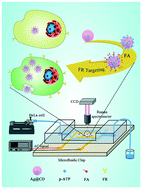Uptake of silver nanoparticles by DHA-treated cancer cells examined by surface-enhanced Raman spectroscopy in a microfluidic chip†
Abstract
This paper reports on the synthesis and application of biocompatible and sensitive SERS nanoparticles for the study of uptake of nanoparticles into living cells in a microfluidic chip through surface-enhanced Raman spectroscopy (SERS). The nanoparticles were fabricated as beta-cyclodextrin-coated silver nanoparticles (Ag@CD NPs) modified with para-aminothiophenol (p-ATP) and folic acid (FA) on the surface. The p-ATP molecules act as the Raman reporter while the FA tags have high affinity for folate receptors (FR) that are over-expressed on the surface cancerous cells, so that the nanoparticles can enter the cells and be monitored by the Raman reporter. Therefore, the nanoparticles could be utilized not only as cell invaders due to endocytosis but also as a SERS sensitive probe to monitor the effect of FR-targeted drugs such as dihydroartemisinin (DHA) that induce the population change of FR on the membrane of living cells. As a result, we have successfully demonstrated that we are able to employ the Ag@CD@p-ATP@FA NPs to evaluate the number of NPs entering living cells quantitatively and correspondingly the drug effect on cancer cells in a well-controlled way.



 Please wait while we load your content...
Please wait while we load your content...